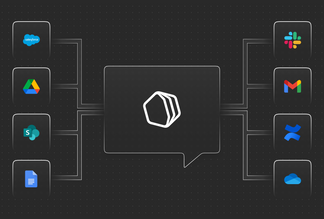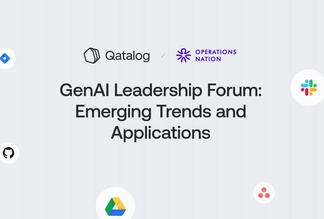
It’s time to define a new way of work
The last time you shared your screen with colleagues, you shared a lot more than the latest version of a presentation. You let your colleagues into your work home. Not the work home with the new backdrop setup for Zoom meetings. The work home that you look at for hours everyday — your laptop screen, and all the tools and docs and other things packed into it.
What do they usually see? If you work in a modern company, there's a good chance it's a jungle of Slack messages, Google docs, Asana tasks, or code in GitHub that you’d been switching between right before the meeting started. Unless you minimized the windows, so it's all just waiting for you after the call.
Your work home is a powerful indication of whether you’re operating in a place of peace, order, and balance — or somewhere else.
For most, that place is somewhere else.
We have a new SaaS app for every niche need, to the point where each team in a company seems to go out of its way to use a different tool. And each tool, each browser tab, each alert creates an environment more like a carnival than a zen home.
In our attempt to promote new ways of working, we’ve adopted too many SaaS tools that in aggregate produce a counter-effect. We’ve gone full-circle.
There are of course many incredible SaaS applications out there. But the ability to balance them together so they don’t interfere with each other, or become walls, has become a rare art.
Perhaps nowhere is this pain more acute than in tech companies experiencing the havoc of hyper-growth. But the challenges certainly aren’t limited to this group. Any company that segments its work by teams has employees that battle this complexity on a daily basis. Teams develop micro-cultures with their own language, acronyms, data, work styles, and now tools.
Layer on top of this concoction the fact that 90% of employees are operating in a remote capacity—many for the first time—and we have a perfect storm of SaaS app chaos.
As a surprisingly large number of jobs can be done remotely, and many companies have implemented remote work plans that are unlikely to reverse, this new paradigm means a stark contrast will emerge between companies that are problem-aware and nail these challenges head-on, and those that flutter in this increasingly digital work life.
So what symptoms should team leaders watch for?
The new way of work reduces noise
A typical knowledge worker makes 35,000 micro-decisions a day. It’s a constant struggle not only to make all those decisions, but to determine what data points should inform them, and what can be discarded. With the rise of hustle culture, many think it’s just a matter of working harder. Not smarter.
Much of this can be addressed by fostering a culture that values quality over quantity. It's also important to make sure that people, teams, and projects are visible and accessible across the organization, without the need for real-time coordination. Because all-day video meetings result in no time to get s%$& done.
This balance between synchronous and asynchronous is critical to getting the context you need to work productively.
Eliminates constant context-switching
But once people are freed from video calls to really get down to work, the struggle to cycle between tools also becomes very real. This form of multi-tasking can lead to a 40% loss of productivity.
Meanwhile, the SaaS market is expected to keep growing—as companies who signed onto different productivity and collaboration tools during the pandemic are unlikely to turn them off—so the cognitive weight of all this context-switching may very well grow.
According to one study, the optimal way to multi-task is to do 52 minutes of work with 17-minute breaks. We’re not robots, but these types of benchmarks can provide a healthy reminder to stop app shuffling and start focusing.
Makes routines collective
Of course, most companies don’t operate with school-like schedules of defined periods and transition times to get between classes. But they could certainly use better collective routines.
Fortunately, collective routines don’t always need to be done at the same time. For example, team members could each start their day by looking at a common dashboard, even if they’re in different time zones. Or they could each finish their day by posting an update with just enough detail, and for the right audience.
Improves visibility
When team members don’t know what they don’t know, collaboration can only go so far. No wonder employees say transparency is the number one factor in determining their work happiness. Teams that make their work discoverable to colleagues when they produce a new artifact, for example, can make significant strides in building a sense of connection.
This is especially the case for distributed teams, where frequent, transparent, consistent communication becomes essential. Without it, team members will parse the meaning of emojis, phrases, or punctuation to an unnerving degree.
Stops process confusion
Helping your teams transform their digital work homes into true clearings also means taking the ambiguity out of basic procedures. Defining clear, step-by-step processes for activities like onboarding remote hires or getting sign-off for a virtual event can have a surprisingly massive impact on morale.
For example, 83 percent of employees who received an updated work from home expense policy said their employer fairly compensates them, compared to only 29 percent where the policy wasn’t updated.
To be sure, in most of the corporate world, there’s no shortage of procedure. But with distributed work on the rise, there’s a new opportunity to define lightweight processes for the sake of clarity. Otherwise, too much flexibility can actually stress employees out, to the point of not knowing when to start and stop work.
Hope amid a sea of SaaS apps
Awareness of these problems alone will not solve them. And in high-growth, segmented, or distributed organizations, it can be both socially and technically complex to achieve a sense of cohesion between teams.
There’s talk of a need for a new work nucleus, or a new metalayer that bridges the many gaps between teams and within them. Knowledge workers, managers, and executives all need to find that glue that lets them escape the digital mayhem.
Businesses that figure this out will win. The coming months and years of work will be led by companies that empower their distributed workforces to operate with a different type of rhythm. They’ll attract top talent, grow market share, and earn the type of soft power that you hear about in politics—the non-tangibles that create gravitas. And they’ll define a new way of work.
Those that just turn on Zoom all day, trying to replicate the in-person, will run out of time.



